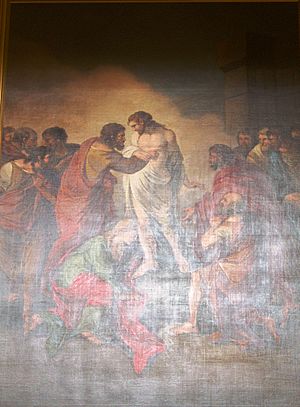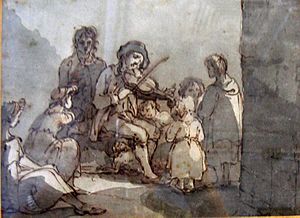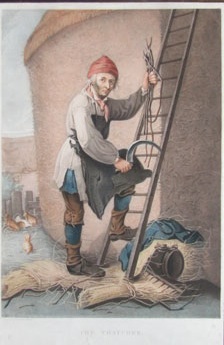Joseph Barney facts for kids
Joseph Barney (born 1753 in Wolverhampton, died 13 April 1832 in London) was a British artist. He was a talented painter and engraver. People often say he learned from famous artists like Antonio Zucchi and Angelica Kauffman. He also painted fruits and flowers for the Prince Regent, who later became King George IV.
Two of his biggest paintings are altarpieces, which are artworks placed behind an altar in a church. These are The Deposition from the Cross (painted in 1781) and The Apparition of Our Lord to St Thomas (painted in 1784). You can see them today in Wolverhampton at St John's church and St Peter & St Paul's Roman Catholic church. During his life, Joseph Barney's art was highly respected. In 1798, a writer named Stebbing Shaw called him a "native genius" of Wolverhampton. The Wolverhampton Art Gallery also has a drawing by him called A Blind Musician. This drawing shows how skilled and versatile Barney was.
Contents
Discovering Joseph Barney's Life
Early Years and Artistic Beginnings
Joseph Barney was the son of Joseph Barney Senior, who was a local japanner. Japanning was a craft where people applied a special lacquer to objects, often decorating them with paintings. His mother was Eleanor Denholm. Because his father was a japanner, young Joseph learned some art skills early on. He started his art career by painting flowers. These were popular designs for japanned items.
Studying Art in London
Joseph Barney moved to London from Wolverhampton around 1774. In that same year, he won a "Silver Palette" award from the Royal Society of Arts for his flower drawings. He studied with Antonio Zucchi sometime between 1774 and 1780. In 1777, he showed his art at the Society of Artists. It was mentioned that he exhibited "at Mr Zucchi's, John Street, Adelphi."
Some people believed he also studied with Angelica Kauffman. She was a very popular and successful artist and a co-founder of the Royal Academy of Art. She later married Zucchi. While Barney was likely influenced by her work, there is no clear proof that she was his teacher.
During his career, Barney showed more than a hundred artworks. He exhibited at the Royal Academy and the British Institution. His art shows that calling him just a "Fruit and Flower Painter" isn't quite right. Only a few of his exhibited works were flower paintings. Most of his recorded works were religious, historical, or genre paintings. This shows he really wanted to be known as a historical painter. In 1774, he won an award for his flower designs. But in 1781, he won a Gold Palette for his historical drawings.
Working with Matthew Boulton
Barney returned to Wolverhampton around 1779. He married Jane Whiston Chambers (or Chandler) in August 1779. Their first child was born in October 1780. He needed to earn money to support his family. By November 1779, he began working with Matthew Boulton (1728–1809). Boulton ran the Soho Manufactory, a famous factory.
Barney helped create "mechanical paintings" there. His job was to add finishing touches and paint to images. These images were copied mechanically from original paintings onto paper or canvas. He worked on copies of paintings by famous artists like Sir Joshua Reynolds, Benjamin West, Joseph Wright of Derby, Antonio Zucchi, and Angelica Kauffman. All the paintings Barney worked on at Soho were figurative, meaning they showed people or scenes. Many were complex, with many figures, like those by Benjamin West and Angelica Kauffman.
Important people like Matthew Boulton and Josiah Wedgwood owned mechanical paintings finished by Barney. Other customers included Mrs. Elizabeth Montagu, Sir Sampson Eardley, 1st Baron Eardley, and possibly others like Beilby Porteus and Lord Macclesfield.
Becoming an Independent Artist
In 1781, Boulton stopped making mechanical paintings, so Barney's work with the Soho Manufactory ended. By 1784, Barney was still in the Midlands. He painted his second altarpiece, The Apparition of Our Lord to St Thomas. He also exhibited his work at the Royal Academy from Birmingham.
Between 1786 and 1793, he lived in London. He actively showed his figurative and historical paintings at the Royal Academy. During this time, he was also known as an engraver and print-seller. His painting Scene in the ‘Tempest, shown in 1788, might mean he wanted to join the Boydell's Shakespeare Project. His friends Benjamin West and Angelica Kauffman were part of this project. One of Barney's students during this time was William Armfield Hobday, who later became a well-known court painter.
In October 1793, Joseph Barney became the Second Drawing Master for Figures. This was at the Royal Military Academy, Woolwich. He moved to Greenwich and stayed at the Academy until 1820.
Being a drawing master influenced the subjects of Barney's later paintings. They became more sentimental but still showed figures, not just fruits and flowers. These works also show his close work with other artists like Francis Wheatley and Charles Turner (engraver). However, his later works were generally not as good as his earlier paintings. In 1796, a reviewer commented on his painting Inside of a Stable: "We have seen a great many better things of this sort than this is - it wants effect and truth of colouring."
Joseph Barney did not fully achieve his artistic dreams. Today, his name is mostly linked to the short-lived mechanical paintings. He is also known for a few "fruit and flower" pieces and some simple prints. Many of his large historical and religious paintings are now lost. But the number and titles of his works show he was an important part of the London art scene in the late 1700s and early 1800s. His early altarpieces in Wolverhampton show his strong artistic talent. This talent was recognized and respected by people who lived at the same time as him.
When Joseph Barney died in April 1832, The Staffordshire Advertiser newspaper reported it. They wrote: "On the 13th inst., at his house, Stanhope-Terrace, Regent's Park, London, Joseph Barney, Esq. [died], aged 77. He was an eminent painter, and for more than 30 years drawing master at the Royal Military Academy, Woolwich. The altar pieces at St John's Church and at the Catholic Chapel, in Wolverhampton, of which he was native, formed lasting monuments of his skill as an artist."
Joseph Barney's Children
Joseph Barney had several children:
- Jane Whiston, born in 1780.
- Joseph (1783-after 1851). He also became an artist. He started showing his art in 1817 from his father's address. He later moved to Westminster and then to Southampton. He was a drawing teacher and mainly painted fruits and flowers. In the late 1830s, he became the Fruit and Flower Painter to Queen Victoria. It's possible that some of his artworks have been mistakenly thought to be by his father.
- William Whiston, born in 1785. He received art training but later joined the army. He became famous for his service in the Peninsular War.
- George (1792–1862). He became a soldier and military engineer. He also served in the Peninsular War and in the West Indies. He later played a significant role in the history of Australia.
- Sophia, born in 1793.
- John Edward (1796–1855).
- Ellen, born in 1799.





